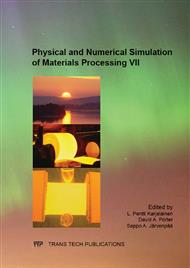p.627
p.633
p.639
p.644
p.649
p.656
p.662
p.668
p.673
The Possibility to Use Optical Emission Spectrometry for Identifying the Amount of Inclusions in Steels
Abstract:
Optical emission spectrometry, OES, has been used widely to define the chemical element analysis. The possibility to use OES-PDA-data to identify the amount of inclusions in steel has been studied to get a quick knowledge about inclusions during the process. From the histogram of intensity levels the amount of chemical element being in steel matrix and in inclusions can be observed. The inclusions are observed to be in the tail of histogram. The setting of a correct threshold to divide the histogram into steel matrix and inclusions parts isproblematic. In this research some statistical methods and a histogram threshold method are tested for OES-PDA-data from steel samples.The research discussed in this paper has been carried out in co-operation with Ruukki Metal, at their Raahe Works in Finland. Steel samples were taken from different process stages and different process routes. The objective was to examine the amounts of inclusions at different process stages and how they differ during the process. The research was focused on the chemical elements that are most common in the inclusions. From the results it is observed that calcium and aluminium are identified pretty well, but for other elements both correct and incorrect results are obtained. This method shows a potential to identify the amount of inclusions, though further research is needed.
Info:
Periodical:
Pages:
649-655
Citation:
Online since:
July 2013
Authors:
Keywords:
Price:
Сopyright:
© 2013 Trans Tech Publications Ltd. All Rights Reserved
Share:
Citation:


